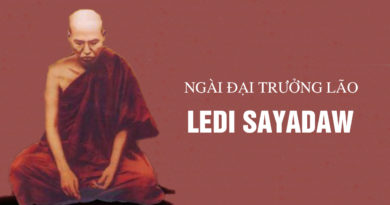A Manual Of The Dhamma – The Three Types Of Monks Defined – Ledi Sayadaw
The Three Types of Monks Defined
The lay people asked this question in the following sense: different kinds of Buddhist monks can now be found: scrupulous monks (lajjī), who possess moral conscience; shameless monks (alajjī), who possess no moral conscience, and immoral monks (dussīlo), who are depraved and evil. They want to know the essential characteristics of each type for classification according to the Pāḷi texts, Commentaries, and Subcommentaries.
The three types of monks have been mentioned in the Parivāra Pāḷi (Vinaya Piṭaka) as follows:
“Sañcicca āpattiṃ nānāpajjati, āpattiṃ naparigūhati.
Agatigamanañca nagacchati, ediso vuccati lajjī puggalo.”
The meaning is this: “They are aware of the Vinaya rules and, with no thought of transgression, refrain from breaking them. If they transgress some rules due to human weakness, they never conceal their offences. Moreover they do not follow the four wrong courses (agati).² Such monks are called scrupulous individuals (lajjī puggala) — monks with moral conscience.”³ These are the three factors or characteristics of a scrupulous monk. The clarification is as follows:
- When a scrupulous monk knows that any action is a transgression of the Vinaya rules, he refrains from it.
- However, he might sometimes break some Vinaya rules knowingly or unknowingly due to his untamed mind. He never hides the facts and always purifies his morality according to the rules within a day.
- When he has to distribute property or decide cases, he avoids the four wrong courses, i.e. he always acts or decides justly and impartially.
A monk having these three factors or characteristics is called scrupulous. This is the meaning of the text quoted above.
The three factors or characteristics of a shameless monk are stated in the Parivāra as follows:
“Sañcicca āpattiṃ āpajjati, āpattiṃ parigūhati.
Agatigamanañca gacchati, ediso vuccati alajjī puggalo.”
This text says that a shameless monk is one who, with the knowledge of the Vinaya rules, transgresses them and commits evil. Having committed evil, he then conceals his actions. Moreover, he follows the four wrong courses. Such a monk is called shameless.
The meaning is as follows:
- A shameless monk, knowing that any action is contrary to the Vinaya rule, breaks the precepts wilfully.
- Whether by his awareness of Vinaya or by his transgression through ignorance, he conceals his faults, though he knows he has broken the Vinaya rule. That is, he does not attempt to purify his faults in the way prescribed.
- When distributing property among monks, or in deciding cases, he follows the four wrong courses.
If even one of these factors is present, such a monk is shameless.
Here, a detailed explanation is necessary. The Vinaya Commentary says: “One who is shameless from the start does not exist.” So shamelessness is impermanent. In other words no such individual as a permanently shameless monk exists. The Commentary says that at the time of ordination a monk cannot be classified as shameless, but he may become shameless according to his mental attitude at any given moment. No monks are permanently scrupulous or shameless based on social class, religion, nationality, etc. A monk may become shameless ten times, or scrupulous ten times within a few minutes. It is possible that within a single sitting a monk may become shameless or scrupulous ten times alternately.
How is this possible? Several Vinaya rules can be broken repeatedly within a short time, so a monk may be classified as shameless more than ten times. Even within a short period, thousands of precepts may have to be observed, which some monks do no know about. Due to his wrong attitude or carelessness, a monk may break them very often. So for that duration he must be classified as shameless. On the other hand if he becomes ashamed whenever he transgresses the rules, realises his fault, confesses it, and determines not to repeat it, he becomes a scrupulous monk again.
Clearly, scrupulous and shameless categories cannot be associated with race, religion, or culture, nor can any monk be permanently classified as scrupulous or shameless. Nevertheless, if a monk does not follow the principles of the monastic discipline throughout his life he should definitely be classified as a shameless monk.
The Vinaya Commentary says that a shameless monk remains shameless only when shamelessness appears in him, and when he possesses one of three factors without confession and purification. As soon as he does these things, he immediately regains the status of a scrupulous monk. In the Sāratthadīpanī Subcommentary the following important explanation is found:
“Ādito paṭṭhāya hi alajjī nāma natthīti iminādiṭṭhadiṭṭhesuyeva āsaṅkhā na kātabbāti dasseti.”
“Herein: ‘One who is shameless from the start does not exist’ means that one must not cast doubt or suspicion on a monk whenever one sees him, thinking that he is shameless. This attitude should not be taken.” This is the advice of the Subcommentary.
Only when one sees a monk doing an immoral deed, can one classify him as shameless at that time and place, and at no other. Moreover, one can doubt this monk’s behaviour then only, and so entertain suspicion. If one does not really see a monk’s act of immorality, no suspicion should be entertained. This is the meaning of the Pāḷi text, Commentary, and Subcommentary.




